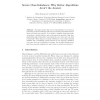Free Online Productivity Tools
i2Speak
i2Symbol
i2OCR
iTex2Img
iWeb2Print
iWeb2Shot
i2Type
iPdf2Split
iPdf2Merge
i2Bopomofo
i2Arabic
i2Style
i2Image
i2PDF
iLatex2Rtf
Sci2ools
ECML
2005
Springer
2005
Springer
Severe Class Imbalance: Why Better Algorithms Aren't the Answer
This paper argues that severe class imbalance is not just an interesting technical challenge that improved learning algorithms will address, it is much more serious. To be useful, a classifier must appreciably outperform a trivial solution, such as choosing the majority class. Any application that is inherently noisy limits the error rate, and cost, that is achievable. When data are normally distributed, even a Bayes optimal classifier has a vanishingly small reduction in the majority classifier’s error rate, and cost, as imbalance increases. For fat tailed distributions, and when practical classifiers are used, often no reduction is achieved.
| Added | 27 Jun 2010 |
| Updated | 27 Jun 2010 |
| Type | Conference |
| Year | 2005 |
| Where | ECML |
| Authors | Chris Drummond, Robert C. Holte |
Comments (0)

